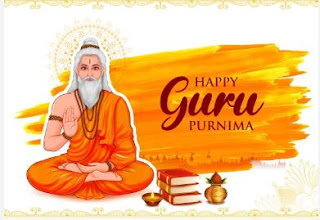Introduction:
Purnima, also known as Vyas
Purnima, is a sacred festival celebrated in various countries and cities of the
world to pay homage to a great spiritual master. This festival is celebrated on
the day of the Hindu month of Ashdha, which is a full moon night. Which usually
comes in July. This festival is given a lot of importance in Hinduism,
Buddhism, and Jainism. In this festival, his disciples from all over the world
express their gratitude to their Guru and pay homage to him. The purpose of
celebrating this festival is to highlight the attributes of Gurupur Nima, their
great historical and mythological significance and the importance of Guru's
relationship in rituals and ceremonies and human lives.
Historical and Mythological Significance:
Guru Purnima has great historical
and mythological significance. This festival is celebrated in honor of the
birth anniversary of Ved Vyas. A great person who is revered as the author of
Maha Bharata, one of the oldest Indian epics. Considered one of the great gurus
of the Vedvyas, Gurupur Nima compiled and wrote down the vast knowledge of the
Vedas and divided them into four parts, the Rigveda, the Yajarveda, the
Samaveda and the Atharveda.
According
to Hindu mythology, Guru Nipurimar is considered to be Lord Shiva, (the first
yogi) which means he was the first guru of Hinduism, Jainism, and Buddhism. On
this great and auspicious day, Gurupur Nima began to teach the science of yoga
to his seven disciples, known as Saptarishas in Hinduism, in the Himalayas.
This
day commemorates the teachings of Hinduism as well as the life and teachings of
Gautama Buddha. who delivered his first sermon on this day at Sarnath near
Varanasi after enlightenment. It is believed that the first five disciples of
the Buddha, who had previously deserted him, reappeared and became his first
regular followers after hearing his sermon. This event also marked the
establishment of the Sangha, which later became the Buddhist monastic community.
Rituals and Celebrations:
Guru Poornima is a day full of
honor, gratitude, and respect. Devotees wake up early and start each new day
each day with spiritual practices such as meditation, yoga, mantra, and prayer.
They offer flowers, incense, and fruits at the altars of their gurus as a sign
of respect and love.
A
large number of people go to ashrams, temples, and spiritual centers to seek the
good wishes and blessings of their Guru. Students participate in dassangs
(spiritual gatherings) and listen to enlightened speakers. Such gatherings
provide an opportunity to learn from the wisdom and knowledge of gurus and
spiritual leaders and to attain spiritual and emotional peace.
The
day is also marked by Gurupuja which is considered a step of ritual worship.
Disciples of gurus and spiritual leaders perform a wide range of rituals. These
rituals include bathing the feet, offering flowers, performing aarti (lighting
a lamp), and seeking good wishes and prayers from them. Rituals are thus a sign
of gratitude for the services of the guru for the disciple's guidance and
teachings.
In
public and private educational institutions, students thank their teachers for
imparting knowledge and shaping their lives better. Various cultural programs
are also organized on this occasion, including traditional dances, musical
shows, drama, and others. Included. The purpose of all these celebrations is to
pay tribute to the wisdom and contribution of the Gurus.
Importance of the Guru-Disciple Relationship:
The
personal and spiritual growth of any disciple is dependent on his relationship
with his guru. A guru who possesses deep spiritual knowledge and wisdom brings
out the disciple's capacity for self-realization and guides him on the path of
life's decision and realization. Gurus impart not only theoretical knowledge to
their disciples but also practical techniques and methods to cope with the
various miseries and challenges of life and attain spiritual enlightenment.

